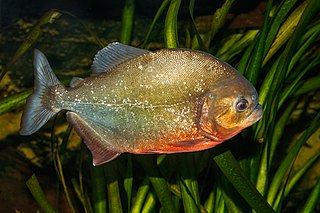
A piranha or piraña is any of a number of freshwater fish species in the family Serrasalmidae, or the subfamily Serrasalminae within the tetra family, Characidae in order Characiformes. These fish inhabit South American rivers, floodplains, lakes and reservoirs. Although often described as extremely predatory and mainly feeding on fish, their dietary habits vary extensively, and they will also take plant material, leading to their classification as omnivorous.

The Amazon basin is the part of South America drained by the Amazon River and its tributaries. The Amazon drainage basin covers an area of about 7,000,000 km2 (2,700,000 sq mi), or about 35.5 percent of the South American continent. It is located in the countries of Bolivia, Brazil, Colombia, Ecuador, Guyana, Peru, Suriname, and Venezuela, as well as the territory of French Guiana.

Hevea brasiliensis, the Pará rubber tree, sharinga tree, seringueira, or most commonly, rubber tree or rubber plant, is a flowering plant belonging to the spurge family, Euphorbiaceae, originally native to the Amazon basin, but is now pantropical in distribution due to introductions. It is the most economically important member of the genus Hevea because the milky latex extracted from the tree is the primary source of natural rubber.

Hevea is a genus of flowering plants in the spurge family, Euphorbiaceae, with about ten members. It is also one of many names used commercially for the wood of the most economically important rubber tree, H. brasiliensis. The genus is native to tropical South America but is widely cultivated in other tropical countries and naturalized in several of them. It was first described in 1775.
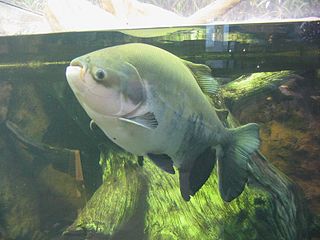
Pacu is a common name used to refer to several species of omnivorous South American freshwater serrasalmid fish related to piranhas. Pacu and piranha do not have similar teeth, the main difference being jaw alignment; piranha have pointed, razor-sharp teeth in a pronounced underbite, whereas pacu have squarer, straighter teeth and a less severe underbite, or a slight overbite. Pacu, unlike piranha, mainly feed on plant material and not flesh or scales. Additionally, the pacu can reach much larger sizes than piranha, at up to 1.08 m in total length and 40 kg (88 lb) in weight.
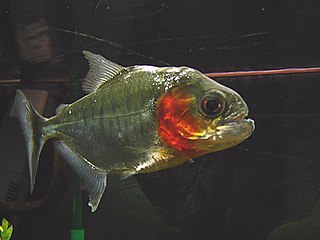
The Serrasalmidae (serrasalmids) are a family of characiform fishes, recently elevated to family status. It includes more than 90 species. The name means "serrated salmon family", which refers to the serrated keel running along the belly of these fish. Fish classified as Serrasalmidae are also known by these common names: pacu, piranha, and silver dollar. These common names generally designate differing dental characteristics and feeding habits.

The red-bellied piranha, also known as the red piranha, is a type of piranha native to South America, found in the Amazon, Paraguay, Paraná and Essequibo basins, as well as coastal rivers of northeastern Brazil. This fish is locally abundant in its freshwater habitat. They are omnivorous foragers and feed on insects, worms, crustaceans, and fish. They are not a migratory species but do travel to seek out conditions conducive to breeding and spawning during periods of increased rainfall. Red-bellied piranhas often travel in shoals as a predatory defense but rarely exhibit group hunting behavior. Acoustic communication is common and is sometimes exhibited along with aggressive behaviors. They are a popular aquarium fish.

The tambaqui is a large species of freshwater fish in the family Serrasalmidae. It is native to tropical South America, but kept in aquaculture and introduced elsewhere. It is also known by the names black pacu, black-finned pacu, giant pacu, cachama, gamitana, and sometimes as pacu.

Piaractus brachypomus, the Red-Bellied Pacu, is a large species of pacu, a close relative of piranhas and silver dollars, in the serrasalmid family. It is native to the Amazon basin in tropical South America, but it formerly included populations in the Orinoco, which was described in 2019 as a separate species, P. orinoquensis. Additionally, P. brachypomus is widely farmed and has been introduced to other regions. In South Florida they are invasive in rivers, canals or lakes.
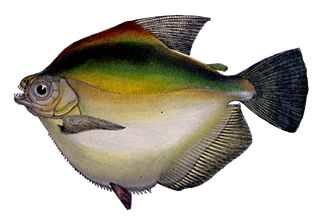
Mylossoma duriventre, the silver mylossoma, is a species of freshwater serrasalmid fish endemic to tropical and subtropical South America. It grows to a maximum length of about 25 cm (10 in) and a weight of 1 kg (2.2 lb). It is the subject of a local fishery, being known as 'pacu' in Brazil and 'palometa' in Venezuela.

The Japurá–Solimões–Negro moist forests (NT0132) is an ecoregion of tropical moist broad leaf forest in the Amazon biome.
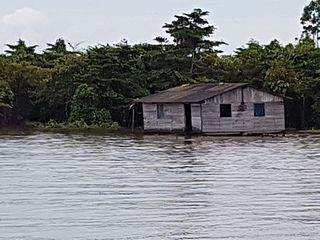
The Gurupa várzea (NT0126) is an ecoregion of seasonally and tidally flooded várzea forest along the Amazon River in the Amazon biome.

The Monte Alegre várzea (NT0141) is an ecoregion of seasonally flooded várzea forest along the Amazon River in the Amazon biome.

The Purus várzea (NT0156) is an ecoregion of seasonally flooded várzea forest in the central Amazon basin. It is part of the Amazon biome. The ecoregion is home to a vegetation adapted to floods of up to 12 metres (39 ft) that may last for eight months. There is a great variety of fish and birds, but relatively fewer mammals. Ground-dwelling mammals must migrate to higher ground during the flood season. Threats include logging, cattle farming, over-fishing and mercury pollution from gold mining.
Hevea nitida is a species of rubber tree in the genus Hevea, belonging to the family Euphorbiaceae. It is a medium-sized evergreen tree up to 27 m (90 ft) tall. It is native to the rainforests of northern Brazil and Colombia.

Hevea guianensis is a species of rubber tree in the genus Hevea, belonging to the family Euphorbiaceae. It is native to the rainforests of Ecuador, Venezuela, the Guyanas, Brazil, Colombia and Peru. It generally grows on well-drained soils or on those that are only lightly inundated, on river banks, in gallery forests, savannah forests and wooded slopes.
Hevea rigidifolia is a species of rubber tree in the genus Hevea, belonging to the family Euphorbiaceae. It is native to the rainforests of northern Brazil and Colombia, where it is endemic to localities near the upper Rio Negro, a north bank tributary of the Amazon River, and its tributary, the Vaupés River.

Hevea benthamiana is a species of rubber tree in the genus Hevea, belonging to the family Euphorbiaceae. A medium-sized deciduous tree growing to a height of about 27 m (90 ft), it is native to the rainforests of northern Brazil, Colombia and Venezuela.
Hevea microphylla is a species of rubber tree in the genus Hevea, belonging to the family Euphorbiaceae. It is native to the Amazon basin where it occurs in Venezuela, Colombia and northern Brazil. It was first described in 1905 by the German botanist Ernst Heinrich Georg Ule. It is the only member of the genus to be included in the subgenus Microphyllae.
Hevea camargoana is a species of flowering plant in the genus Hevea, the rubber trees, belonging to the family Euphorbiaceae. It is native to the island of Marajó in the Amazon delta in northeastern Brazil where it was discovered in 1975. It is a small tree and Its typical habitat is dry savannah and woodland bordering seasonally inundated swamps.














